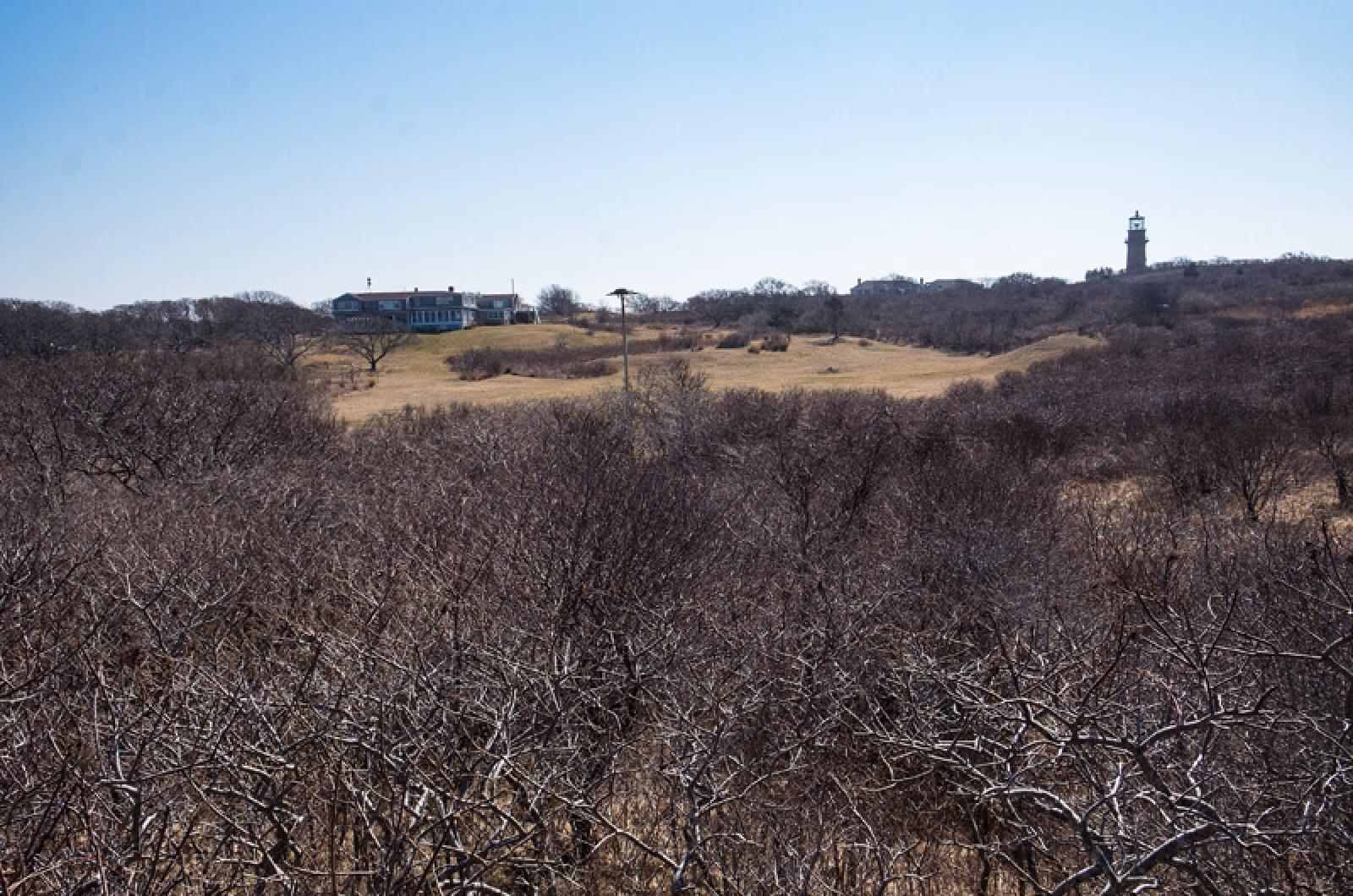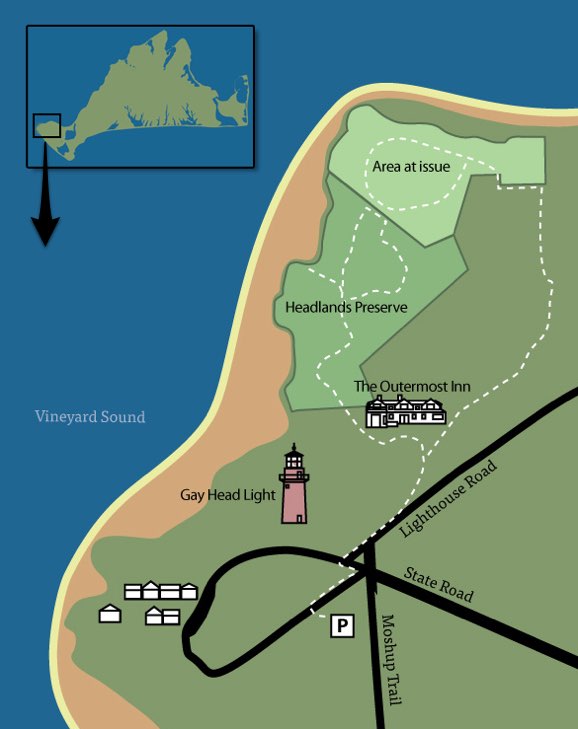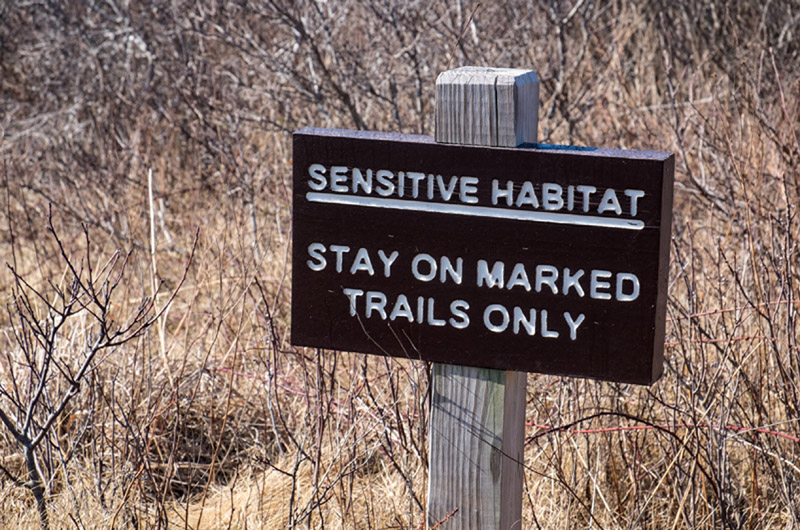An effort to link breathtaking adjacent properties near the Gay Head cliffs with a hiking trail has pitted the Martha’s Vineyard Land Bank against the owners of the Outermost Inn, whose land must be crossed by hikers to access the trail.
The legal dispute between the land bank, which wants to use a loop trail to connect the properties, and the Taylor Realty Trust was the subject of arguments in front of the State Supreme Judicial Court on Tuesday, and featured a glimpse into a relatively obscure but critical corner of real estate law involving easements.
The land bank is one the Island’s largest landholders, and there is no dispute that it owns the two adjacent parcels, which are part of the 49-acre Aquinnah Headlands Preserve. The parcels are in the North Head section that opened to the public in 2011 and feature unspoiled land that rolls out to the cliffs northwest of the Aquinnah lighthouse, with views of Vineyard Sound and the Elizabeth Islands beyond.
But a loop trail connecting the parcels has been blocked by the legal dispute. Because those two parcels have been determined to have separate chains of title that afford separate access, those routes resemble a pair of pincers that don’t close at the top, where the parcels share a common property line.
As a result, the North Head trails now in use wander up to and back from the property boundary and out to the cliffs that once held a Coast Guard station, using a right-of-way that is not available to the other, northeasterly parcel. An attorney for Hugh C. Taylor, Jeanne S. Taylor and Brian M. Hurley, who are trustees of Taylor Realty Trust, told the justices that allowing the two parcels to be linked would violate a “bright line rule” against overloading easements that has been in place since the 19th century.
“What the land bank is proposing here is that you adopt a rule or an exception that is completely unprecedented, that is untethered from the very basic principles of easement law,” said Gordon M. Orloff, representing the Taylor trust. “The land bank is basically saying, you should throw all those out the window.”
However, in this case, the land bank’s lawyers say they do not seek the creation of a new easement, but merely a common-sense exception that would have little or no adverse impact and not overburden the easements.
“There’s absolutely no harm to the Taylors in this case if the court were to find that the land bank could use that adjacent parcel,” which is named Diem lot 5, after a previous owner, said Dianne C. Tillotson, arguing for the land bank.
“We’re not talking about a parking lot being placed on the Diem lot,” said Ms. Tillotson. “We’re not talking about a two-family home in the place of a single-family residence. We’re talking about the same use by the same users … by the same means of transport.”
The North Head portion of the Aquinnah preserve contains several parcels purchased by the land bank in the early to mid-1990s. There are no signs or markers along Lighthouse Road that would direct hikers to the trails; they are situated at the trailhead itself, which is not visible from the road. Parking and a map are available to the southwest, on the other side of the Aquinnah circle by the South Head trailhead.
The available North Head trails are closed in the high season, from mid-June to mid-September. They wind along a mowed path through scrub oak and other vegetation, and previously cut over a ridge onto the adjacent Diem parcel. But as hikers approached the boundary earlier this week, they encountered posted signs warning them to go no farther. The trails on the Diem side of the property line were mostly overgrown.
“It’s not that there’s no access,” observed Associate Justice Barbara A. Lenk at the Tuesday hearing. “There’s just not preferred access.”
Ms. Tillotson said hikers who want to enjoy both properties would in effect have to walk two separate, unconnected loops, which she asserted would intensify use. Access to the Diem lot also passes over a small section of Taylor property near Lighthouse Road, the lawyers said in written arguments.
“But if that’s what the [Taylor trustees] want, why is that for you to say?” Justice Lenk asked.
“The ‘why’ is it makes no sense…,” responded Ms. Tillotson, especially for a conservation organization that is essentially preserving the land for low-impact activities such as hiking.
Mr. Orloff, the Taylors’ attorney, said an exception would create a “substantial burden” on the Taylors. He added that the land bank knew about the “bright line” restrictions before it bought the Diem parcel, but is now asking the courts to skirt it.
“Is it basically your argument that there is more value in keeping a rule without exceptions that doesn’t require a particularized analysis, case by case, even if at times, such as here, the result is just silly?” asked Justice Lenk.
“Well, I don’t know if the result here is silly because the land bank is arguing that, but they haven’t proved that,” said Mr. Orloff. “Certainly there is a value in having a ‘bright line’ rule.”
Mr. Orloff later said any exception should be done prospectively, otherwise recognizing the land bank’s position would in effect be a “taking.”
“That’s exactly what’s being argued to you here: you should enforce a new easement right to a new parcel to allow the public to walk out onto that parcel,” he said. “But that seems to be exactly the kind of taking that the [the court has] prohibited — or said couldn’t be done without compensation.”
At one point, Chief Justice Ralph D. Gants observed that a loop trail across the two parcels would actually offer some benefit to the Outermost Inn and its owners.
“It seems to be an asset to you to have a nice loop trail for folks after their lovely breakfast on the Vineyard, to take a nice little walk along the water and have it be a loop trail,” he said. “That’s why I’m a little bit perplexed why you’re so upset about this.”
Mr. Orloff and Mr. Hurley, the Taylor trustee, represent the Taylor Trust and are lawyers at Rackemann, Sawyer & Brewster of Boston. Ms. Tillotson of Hemenway & Barnes of Boston and Ronald H. Rappaport of Reynolds, Rappaport, Kaplan & Hackney of Edgartown represent the Martha’s Vineyard Land Bank.
This article has been updated to include a clearer map of the area under discussion.






Comments (24)
Comments
Comment policy »